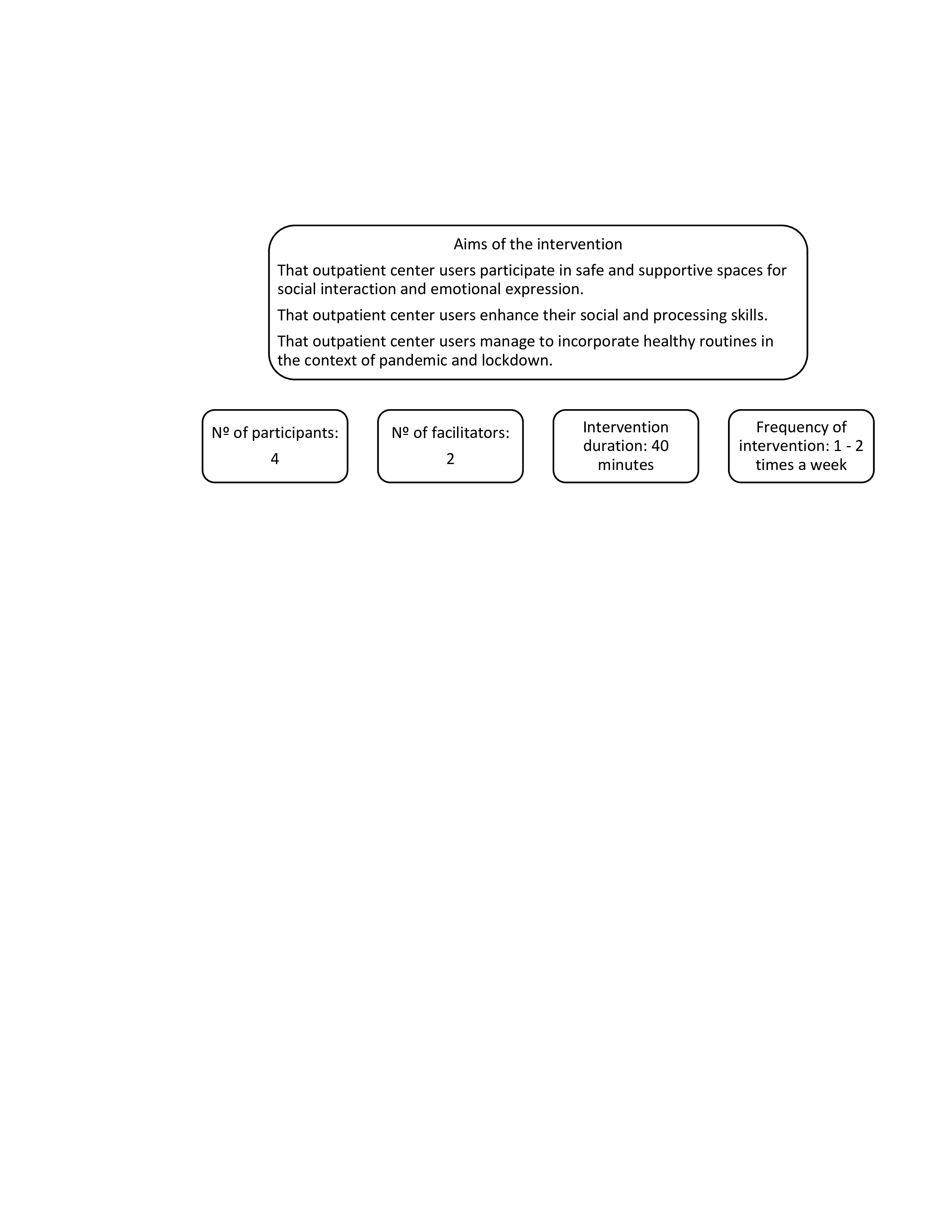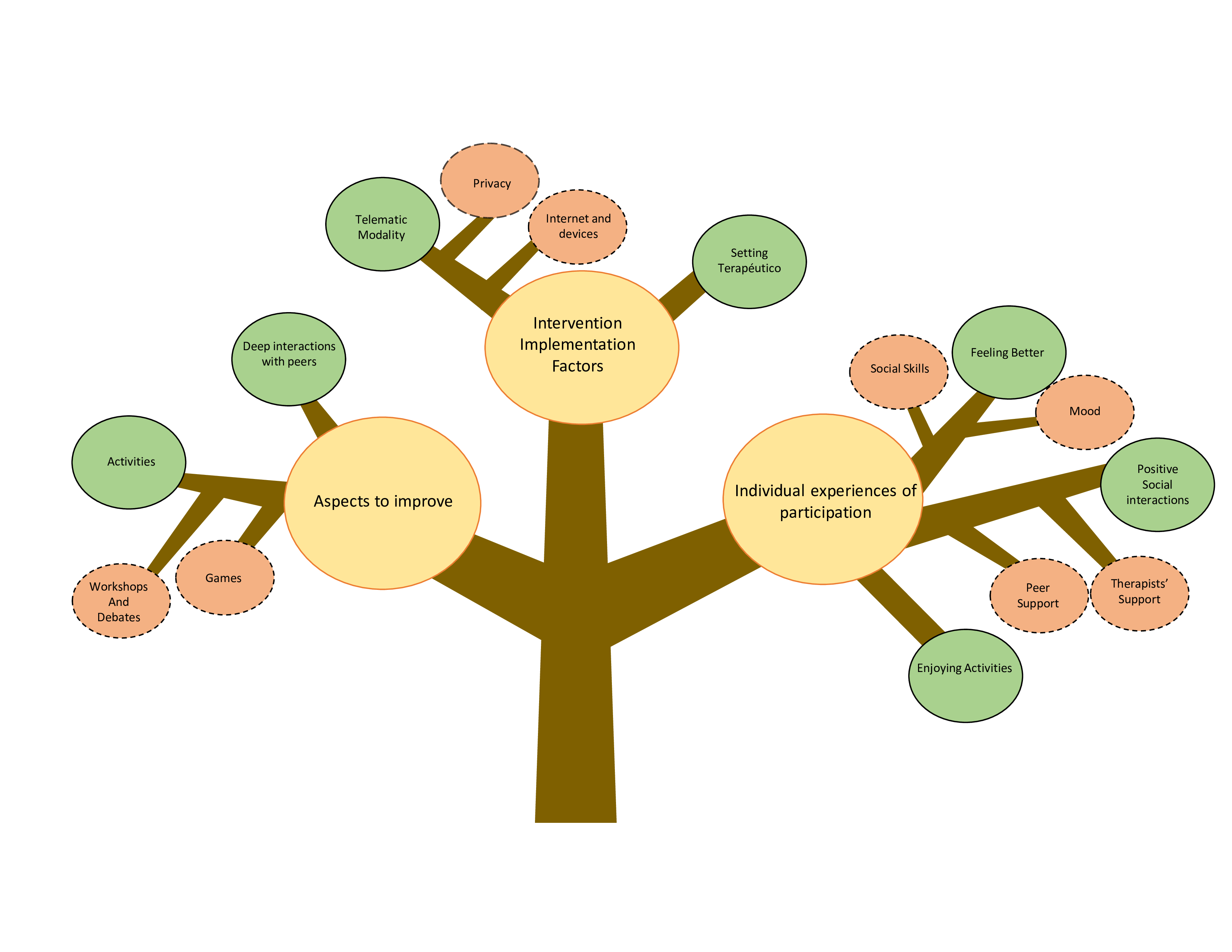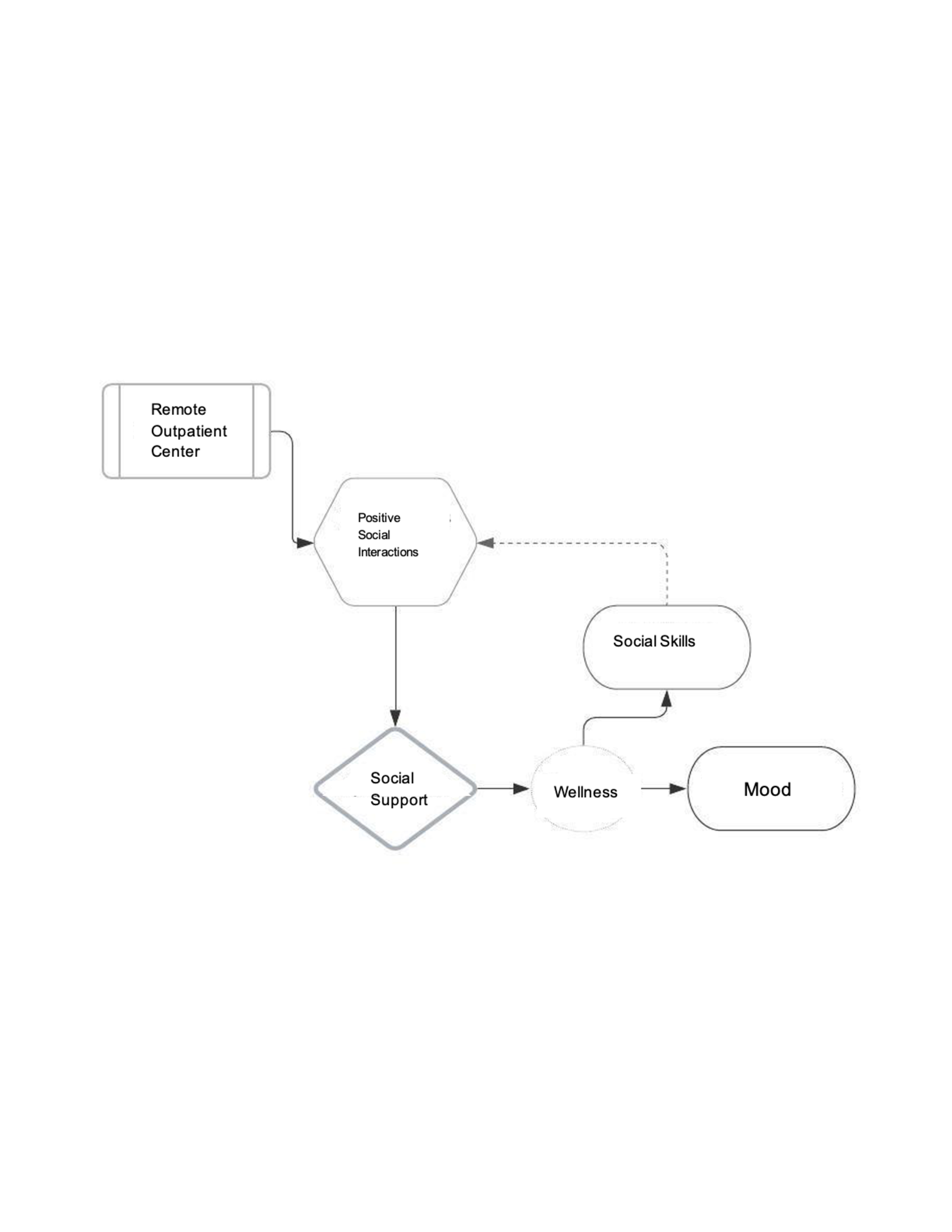Estudio cualitativo
← vista completaPublicado el 26 de mayo de 2023 | http://doi.org/10.5867/medwave.2023.04.2586
Adaptación telemática de las actividades grupales de un hospital de día infanto-juvenil: experiencias de participantes adolescentes
Digital adaptation of group activities in an outpatient center of a children´s hospital: Adolescent participants’ experiences
Abstract
Introduction Outpatient centers offer specialized care to users with severe psychiatric disorders. The usual group activities of outpatient centers have been shown to be effective in the child and adolescent population. There are significant access limitations to these services and one way to expand coverage is through digital care. However, there are no studies on digital outpatient care services in Chile. The present study is part of the preparatory phase of a future randomized clinical trial to investigate the effectiveness of digital adaptation of outpatient centers interventions.
Objectives To explore the experience and subjective perception of the pilot intervention participants by identifying central themes, and to evaluate the participant's satisfaction regarding the intervention.
Methods Of the 13 users of the digital group activities, 10 participated in this study. Semi-structured interviews and satisfaction surveys were conducted between August 2020 and January 2021. The interviews were evaluated using content analysis and the surveys were conducted using descriptive statistics.
Conclusions Results
Participants were particularly appreciative of positive social interactions (with peers and therapists). There is a general perception of having improved socioemotional skills and mood. The digital implementation was satisfactory for most participants, who suggested adding activities that promote deeper interactions with their peers.
The core elements of this intervention would be the perception of social support (a possible therapeutic mechanism), along with the feeling of improved social skills and mood (possible main outcome).
Main messages
- Evidence on the effectiveness of digital interventions in child and adolescent psychiatry is still scarce.
- There are no studies on digital outpatient care services in Chile, and the number of these centers for the child and adolescent population is insufficient, with significant access barriers.
- The information from this work, being a qualitative study, allows us to know in depth the users' experience of digital interventions in outpatient centers and to identify the components that would be important to evaluate in a future controlled trial.
- The main limitations of this study are that the sample is limited to a single site, that the origin of the data is limited, and that no saturation sampling criterion was used.
Introduction
Outpatient centers are points of care for specialized daytime hospitalization, integrated into the mental and general healthcare networks [1]. The target population of child and adolescent outpatient centers corresponds to children and adolescents (aged 10 to 17 years) with a serious mental health illness, undergoing a period of exacerbation of their symptoms, or transitioning from a closed hospitalization [1]. The outpatient centers aim to stabilize the user, favoring the development of skills that promote well-being and resilience through intensive treatment with articulated and comprehensive interventions while remaining in their family and community [1,2].
Interventions consist mainly of specialized individual and group sessions for users with severe mental health diseases. These have proven effective for adolescents with psychiatric disorders [3].
Evidence suggests that outpatient centers are effective and, unlike closed psychiatric hospitalization, reduce social stigma and the disruption of community bonds, especially at an early age [2,4].
In Chile, there are twelve child-adolescent outpatient centers, a number that has been considered insufficient [1]. The cost of transportation, geographic barriers, noncompliance with criteria for admission to treatment, and location of outpatient centers are major obstacles to accessibility. In this context, digital outpatient care services delivery emerges as a cost-effective alternative capable of favoring access to more isolated populations or those with more access difficulties [5,6,7,8,9,10,11].
Digital care in psychiatry has generally been positively evaluated without differences in the therapeutic alliance or user satisfaction [5].
In child and adolescent psychiatry, the results of digital evaluations have been found to have a high degree of equivalence with those performed in person [12]. In addition, they are welcomed by users [9,10,12]. Two recent reviews [7,8] report an accelerated proliferation of digital interventions for preventing and treating mental health conditions in Chile and Latin America, which has increased considerably in the context of the COVID-19 pandemic [13,14]. The feasibility of these interventions in the child and adolescent population with adequate levels of acceptability is highlighted. However, evidence on the effectiveness of digital interventions in child and adolescent psychiatry is still scarce [8].
In response, the present study is part of the preparatory phase of a future randomized clinical trial to investigate the effectiveness of digital adaptation of outpatient care services (Figure 1) and aims to:
-
To explore the experience and subjective perception of the pilot intervention participants by identifying central themes.
-
To evaluate the participant’s satisfaction with the intervention.
Elements of the digital intervention/adaptation of group activities in the outpatient center.

As specific objectives, we seek to infer from these central themes:
-
Possible therapeutic mechanisms.
-
Possible outcomes.
In relation to how the digital adaptation was carried out, it should be noted that the number of participants in each group was four people. This varied depending on attendance at the sessions. The sessions had a duration of 40 minutes which was determined by the use of the free version of Zoom; the frequency of the sessions (once or twice a week) was determined according to the characteristics of the users and the comprehensive care plan. The groups were defined considering clinical aspects and the developmental stage of the participants.
Methods
Design
A mixed design was employed to explore the user experience of a mental health group intervention based on the remote delivery of outpatient care services at a hospital in the Metropolitan Region, Chile. The Consolidated Standards of Reporting Trials (CONSORT) guidelines for reporting pilot studies were followed.
Instruments and data collection
Between August 2020 and January 2021, 10 interviews developed for this research were applied, using the criteria of experts for the construction of the interview script (specifically, two external researchers with expertise in qualitative studies in mental health), to verify the consistency of the questions with the objectives of the study. These semi-structured interviews were conducted via video call with open-ended questions on the perception of the intervention and its effectiveness, conditions for carrying out the activity, aspects of the remote format, and future suggestions.
Participants were then sent a satisfaction questionnaire asking them to evaluate different elements of the sessions: technical aspects, modality, environment, and impact. This instrument was designed by researchers and submitted to the judgment of three experts in health research.
Participants
All users of the outpatient center who completed a minimum of 16 visits to the interventions were invited to participate, considering an estimated length of stay in the unit of three months.
All users attending the outpatient center (13) agreed to participate. One person was excluded for non-attendance, and two withdrew from the study. The final number of participants was 10, who attended an average of 21 sessions. The sociodemographic characteristics of the sample are detailed in Table 1.
Data analysis
The content analysis method was used for the interviews, a qualitative method that allows for identifying central themes and their schematization [15]. Coding was carried out independently by two researchers (SCC and KBC). Subsequently, this coding was audited by a third researcher (AC), who identified non-concordant categories. These categories were then discussed, and the final categories were agreed upon. The satisfaction questionnaire was analyzed using descriptive statistics.
Ethical considerations
The scientific ethics committee of the Southern Metropolitan Health Service approved this study, as stated in Protocol 49-26062020. Informed consent and assent were obtained.
Results
Participants' characteristics
As detailed in Table 1, 80% of the participants were enrolled in tranches A or B of the National Health Fund (FONASA, state health insurance), which indicates socioeconomic vulnerability since the declared incomes were below the minimum wage [16]. Eighty percent of the participants were in school, three of them attending a hospital school.
Content analysis
From the analysis of the interviews, three central themes emerge individual experiences related to participation in the intervention, factors related to the implementation of the intervention, and aspects to be improved. Figure 2 schematizes the central themes and their sub-themes, the content of which is described below. Table 2 presents textual vignettes extracted from the interviews.
Central themes and subthemes according to the content analysis of the interviews.

Individual experiences of remote outpatient center participation
Peers: participants frequently described satisfaction in feeling part of a group where they shared similar experiences. A sense of belonging and validation is perceived in their testimonies.
In this context, participants highlighted the opportunity to interact with peers during the pandemic in a group where sharing emotions is possible. They valued meeting new people and the way their peers treated them.
Some users even mentioned not having, at the time of the interview, other spaces with peers besides this one.
Therapists: regarding the therapists/facilitators, the participant’s value having a space to express themselves and not feel obligated or judged. They highlight the welcoming and respectful treatment of the facilitators.
The achievement most highlighted by the participants was improved social skills and mood. Most mentioned feeling more communicative, sociable, happier, and less worried after the sessions.
The activities were perceived as fun and interesting. They emphasized being able to express themselves freely and listening to experiences and advice from peers. Playfulness appears as the preferred aspect of the activities.
Intervention implementation factors
Participants reported feeling in a safe and respectful space, highlighting the feeling of friendliness and welcome.
The digital modality is positively valued. The majority considered it superior to the face-to-face modality. The convenience of this modality is frequently mentioned, especially not having to travel and the convenience of sharing with others from a familiar physical space. However, they pointed out the importance of having their cameras on to keep the interactions flowing.
Some participants did not prefer one option over the other but perceived positives and negatives in both.
Most participants mentioned having a private space in their homes to join the activity. However, two participants mentioned not having enough privacy.
Almost all of them mentioned not having problems with the internet or wifi connection.
Some connected from their computers, and others from their cell phones. Those who connected from their cell phones mentioned difficulties such as poor visibility when sharing a screen. In those cases, the reason is the scarcity of computers in their homes (e.g., participant 3). Only one participant reported significant internet connection problems.
Aspects to improve
Special interest was shown for instances of interaction and bonding with peers in a deeper way. In addition, they suggested adding activities such as debates, workshops, and games.
In general, the participants' evaluation was positive, with the majority being satisfied (50%) or very satisfied (50%) with the sessions. The results are detailed in Table 3.
Discussion
This study explored the experience of adolescent users of an outpatient center, being part of a digital adaptation of the usual group interventions in this facility. Based on the central themes identified, the following were analyzed:
-
Possible therapeutic mechanisms.
-
Possible outcomes.
Our results provide an exploratory approach to the possible therapeutic mechanisms of the intervention and its main outcomes [17].
Concerning the general objective, the results show three central themes (Figure 2), each with subthemes:
-
Individual experiences related to participation in the intervention (subthemes: positive social interactions, improving skills, enjoying activities).
-
Factors related to the implementation of the intervention (therapeutic setting and digital modality).
-
Aspects to be improved (deep interactions with peers and activities).
In response to the first specific objective of this study, it is proposed that the most relevant operating mechanism may be social support (i.e., the availability of support available to an individual through his or her social ties [18]). This emerges from analyzing the themes considering the evidence in similar studies [19,20,21]. Thus, components corresponding to social support dimensions can be found in each of the main themes: positive social interactions, therapeutic setting, and deep interactions with peers.
Regarding the second specific objective, we infer that the intervention would mainly aim to improve mood and the ability to socialize. These elements appear especially relevant in the participants' statements, both explicitly (for example, within the subtheme improving socio-emotional skills, feeling in a better mood and greater capacity and interest in communicating with others) and implicitly (reflected in the themes of enjoying activities and positive social interactions) (Table 2).
Thus, the two central elements of this intervention would be the perception of social support and the feeling of improved social skills and mood.
Thus, it is possible to propose a preliminary model (Figure 3) based on the experiences reported by the participants, in which the remote outpatient service provides positive social interactions, which, when constituted as social support, will promote well-being by favoring improvements in mood and social skills. This, in turn, promotes participation in the group, increasing positive social interactions and thus generating a virtuous circle. In summary, this model suggests that social support would be the mechanism, and improvements in mood and social skills would be the main outcomes.
Mechanisms and intervention outcomes model.

This is consistent with scientific evidence. Several studies show how social support promotes well-being and decreases the risk of psychiatric pathology [22,23,24] and how it has a positive effect in different areas of health, for example, as a protector and buffer of stress responses [18,25].
In this intervention, social support would operate through the experience of positive social interactions and in the therapeutic setting, consistent with studies on group interventions [26,27,28]. This would generate an experience of group belonging, offering a possibility of positive identification that positively impacts well-being and health promotion favorably, especially in people with mental health conditions [24,29,30].
Concerning the satisfaction survey, the results (Table 3) reflect a high level of satisfaction among participants in the digital adaptation of group activities. In any case, it is suggested in the future to previously evaluate the resources available to the users (devices, connectivity, and privacy).
Regarding the group characteristics (Table 1), it is worth noting that 20% were not attending school, which highlights the importance of considering school dropout in this population, especially in the current healthcare scenario. In addition, 30% attended hospital school, which could indicate patient severity.
Evidence supports the effectiveness of online group psychosocial interventions [31] and digital social support [32]. Thus, it would be beneficial to further develop this intervention modality in outpatient centers. Therefore, based on the acceptability reported by users, the digital group intervention modality is presented as an alternative that could be incorporated permanently, as it allows the mitigation of certain access limitations.
Limitations and opportunities
This study has major limitations: the sample is limited to a single site, the source of the data is limited, and no saturation sampling criteria were used. Therefore, the sample analyzed, which was chosen for its accessibility, may not be representative of the population of other outpatient centers. Although the instruments used were validated according to accepted standards in qualitative designs, they were not standardized. This could imply subjectivity biases in the measurement and of the participants.
It is important to note that the results do not provide information on the effectiveness of the intervention, so they should be taken cautiously. However, being a qualitative study, the information it provides is useful for the future development of experimental clinical studies since it allows us to know in depth the experience of the users and thus identify the components that would be relevant to evaluate in a future controlled trial.
Thus, the present study aligns with current international recommendations on the richness of conducting qualitative studies before developing randomized controlled trials [33,34]. For example, the UK Medical Research Council framework recommends studying complex interventions using quantitative and qualitative methods [35,36]. Likewise, the American Psychological Association indicates that, in mental health, so-called "evidence-based practice" is built from various research designs that should include qualitative studies [37].
Conclusions
The digital adaptation of outpatient care services proved satisfactory for the users. From their statements, we infer that the central elements of this intervention would be the perception of social support through the sense of belonging to a group (a possible therapeutic mechanism), together with the feeling of improved social skills and mood (a possible main outcome).

